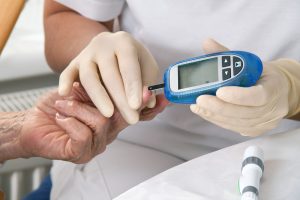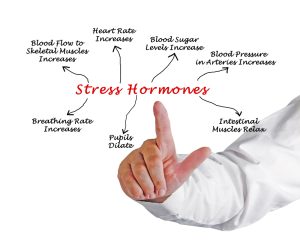Did you know there is such a thing called good stress? Eustress is our basic challenges everyday. They call us to duty. Without these challenges that awaken us and push us to accomplish chores, goals, and dreams, then we would not be able to progress in life. The eustress of the challenges encompassed with earning a degree, or the eustress that accompanies a new but better paying job position, or even the eustress of dealing with the needs of a new infant are all examples of duties and needs individuals must face. When these obstacles are ignored, delayed or forgotten, then worst things happen in life. Jobs are lost, the house becomes a mess, relationships fail and an individual no longer meets goals, deadlines or accomplishes dreams.

There are obstacles and issues with every good thing in life. Waking up and getting out of bed and facing the world is a cross, or obstacle for many but we must do it. The push to face these good stresses keep us alive and ultimately are rewarding. A new position or job, or earned degree, or a beautiful home are all blessings but blessings that are earned. The body responds to these good stressors and realizes that things must be done to continue living, earning, enjoying and fulfilling life. In turn, the body rewards good work with a sense of accomplishment and pride.
Hence it is important to respond to daily life and good stress or eustress are all examples of good stresses that we deal with each day, week, and month. The article, “Good stress vs bad stress: know the difference by paying attention to your body’s reaction – and be alert to the danger of overload” from Tribune News Service looks at the importance of good stress but also warns against the dangers of bad stress. While experts speak of the important of good stress and the resilience and reward it builds in individuals, the article also warns of toxic and bad stress. The article states,
“It may be surprising to hear, but medically speaking, not all stress is bad. Healthy stress levels help build resilience, says Dr Safia Debar, a stress management expert at Mayo Clinic Healthcare in London, a branch of the Mayo Clinic in Rochester, in the US state of Minnesota. She explains the difference between good and bad stress, and how to tell when you are in danger of overload. Stress is a physical and psychological reaction to a demand, and that demand can be anything, Debar says. Stress that is good for us and may even give us a sense of well-being is called eustress, and is the opposite of distress”.
“Good stress vs bad stress: know the difference by paying attention to your body’s reaction – and be alert to the danger of overload”. Tribune News Service. (2023).
To review the entire article, click here
According to the article, events in life, such as marriage, can be great but also stressful. This is referred to eustress. Eustress deals with the things that come with everyday life that surround good events or everyday life itself, from work to school to family. Good stress management skills and organization can prevent these natural stresses which push us towards goals from becoming toxic. Stress Management skills can help us cope and deal with life and find better organization, planning and enjoyment out of it. Hence daily obstacles do not need to incur the fight or flight stress response within the sympathetic nervous system. Instead we can cope and work with life and find joy in accomplishments and find a resiliency within oneself to grow and become stronger.
However, when obstacles become distress, or when even good things become distress due to bad coping, the fight of flight system can be activated. Obviously during a death of a loved one, loss job, conflict, pain, divorce, or natural disaster the body is fighting off distress and the body enters into a state of fight or flight. This is needed in the acute moments to help the body prepare itself for the more demanding issues. The sympathetic system is activated via the pituitary gland and epinephrine a type of adrenaline is pumped into the body, aided by cortisol to increase the heart rate and blood pressure. Muscles are tightened and the digestive system decreases operation to deal with the distress. Overtime, if continual, this can become chronic stress and damaging to the body.
Daily basic stresses that are part of our daily obstacles should not become distress but in many cases they do and the fight or flight response is activated. A party, or a dead line, or a mere family event of joy can all be turned upside down. These good stresses push one to strive to be better and accomplish and should not become distress but for many without stress management skills and good coping and support, they can become detrimental.
Hence it is good to find joy in life and to recognize that daily challenges are not necessarily distress but reminders that we are alive and are correlated with our life choices, connections, accomplishments as well as interactions with those we love. If one is able to better realize this and utilize basic stress management, meditation and coping skills, then one can better see the joy in daily life and its minor obstacles. These obstacles are a product of living and should be embraced and then applauded when accomplishment and satisfaction occur.
So in the future, enjoy the ride. Enjoy the wedding planning, the holiday get togethers, the gift searching, the dinner planning, the first date, the love of a crazy pet, or anything else that surrounds life. Part of living is dealing with by products of good things or obstacles that lead to greater things. They do not need to be seen as the enemy or distress in life but merely part of life and that mindset can change many things.

Please also review AIHCP’s Stress Management Consulting Certification and see if it meets your academic and professional goals. The program is online and independent study and open to qualified professionals.
Additional Resources
“Eustress: The Good Stress”. Lindberg, S. (2018). Healthline. Access here
“What Is Eustress?”. Scott, E. (2022). VeryWellMind. Access here
“What Is Eustress? A Look at the Psychology and Benefits”. Moore, C. (2019). PositivePsychology.com. Access here
“The good stress: How eustress helps you grow”. (2021). The American Institute of Stress. Access here















